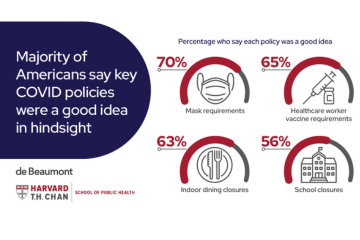Government public health workers played an essential role in responding to the COVID-19 pandemic, and their mental health suffered in the process. The de Beaumont Foundation, in partnership with the COVID-19 and Life Stressors Impact on Mental Health and Well-being (CLIMB) research team, aimed to explain and understand the workforce’s experience with our recently published brief in the Journal of Public Health Management & Practice, “Symptoms of Posttraumatic Stress During the COVID-19 Pandemic in the Governmental Public Health Workforce and General Population.” In the article, researchers compared the prevalence of COVID-19-related posttraumatic stress symptoms (PTSS) in this workforce with estimates in the US general adult population in 2021.
Using the Public Health Workforce Interest and Needs Survey (PH WINS) and the CLIMB study, we found that state and local governmental public health workers were more likely to report COVID-related PTSS than the general adult population. Similarly, frontline workers including home health aides, first responders, social workers, childcare workers, and teachers, were also more likely to report experiencing PTSS than the general public. Despite the COVID-19 emergency declaration expiring in May 2023, the mental health effects of the pandemic on public health and frontline workers remain and require vigilance to ensure the country is ready to address the next health crisis. So, how did we get here, why does this matter, and what can be done?
How We Got Here
It is widely known that the COVID-19 pandemic led to worsening mental health in the US population, with the mental health of healthcare workers responding to COVID-19 being particularly vulnerable. Our research shows that in 2021, 21.1% of adults and 24.7% of the government public health workforce reported three or more post-traumatic stress symptoms, indicating probable PTSD. These may have been driven by experiences such as:
- COVID-19-related harassment: According to PH WINS 2021, over 40% of public health employees agreed with the statement, “I have felt bullied, threatened, or harassed by individuals outside of the health department.”
- Insufficient access to life-saving equipment: Shortages of personal protective equipment (PPE) plagued those responding to the pandemic, forcing public health and healthcare workers to engage in risky behaviors such as reusing single-use N95 masks.
- Insufficient staffing: Nearly three-quarters (74%) of state and local public health employees aged 35 and younger left their workplaces between 2017 and 2021, leaving the public health workforce to respond to a nationwide public health crisis on the heels of losing crucial staff experience and institutional knowledge.
- Lack of sick leave: With healthcare workers being one of the top occupational groups excluded from the benefits of Emergency Paid Sick Leave, those responding to the pandemic were forced to choose between going to work and potentially spreading illness or staying home without pay.
- Communication breakdown: Healthcare workers reported that a breakdown in communication between leadership and the workforce led to feelings of abandonment and chaos.
Why This Matters
Unless meaningful action is taken to address the root causes of poor mental health among the governmental public health workforce, staff turnover will continue to be a challenge. One study using PH WINS data predicted that, should current separation trends continue, more than half of the governmental public health workforce will leave their organization by 2025.
In addition, a healthy, robust workforce is critical to public health’s role in advancing health equity. The workforce’s commitment to community engagement while ensuring access to quality care has laid the foundation for public health departments to be at the forefront of advancing equity.
Finally, the pandemic is a prime example of how the nation’s safety, security, and economic prosperity depend on a strong public health system. The pandemic resulted in long-term mental and physical ailments, increased mortality, and educational losses that could total trillions of dollars. The public health workforce played a critical role in preventing even more death and disability from occurring, and they will be critical in effective responses to future traumatic events.
What We Can Do
Public health and healthcare leaders should invest in systems-level interventions to promote a healthy workplace environment and culture. Considerations include prioritizing appropriate and flexible staffing plans and implementing policies that encourage staff to operate as teams. In addition:
- Public health officials should enact policies to address the root causes of burnout and stress, including reducing stigma and barriers for public health workers seeking mental health services, ensuring that those who seek services will not experience punitive action, and providing robust and affordable mental health services. Mental health assessment, treatment, and recovery for the public health and frontline workforce should be included in preparedness plans moving forward.
- People at a greater risk for PTSS should receive screening and intervention to prevent poor mental health from getting worse and to support the workers who support public health responses to large-scale crises.




